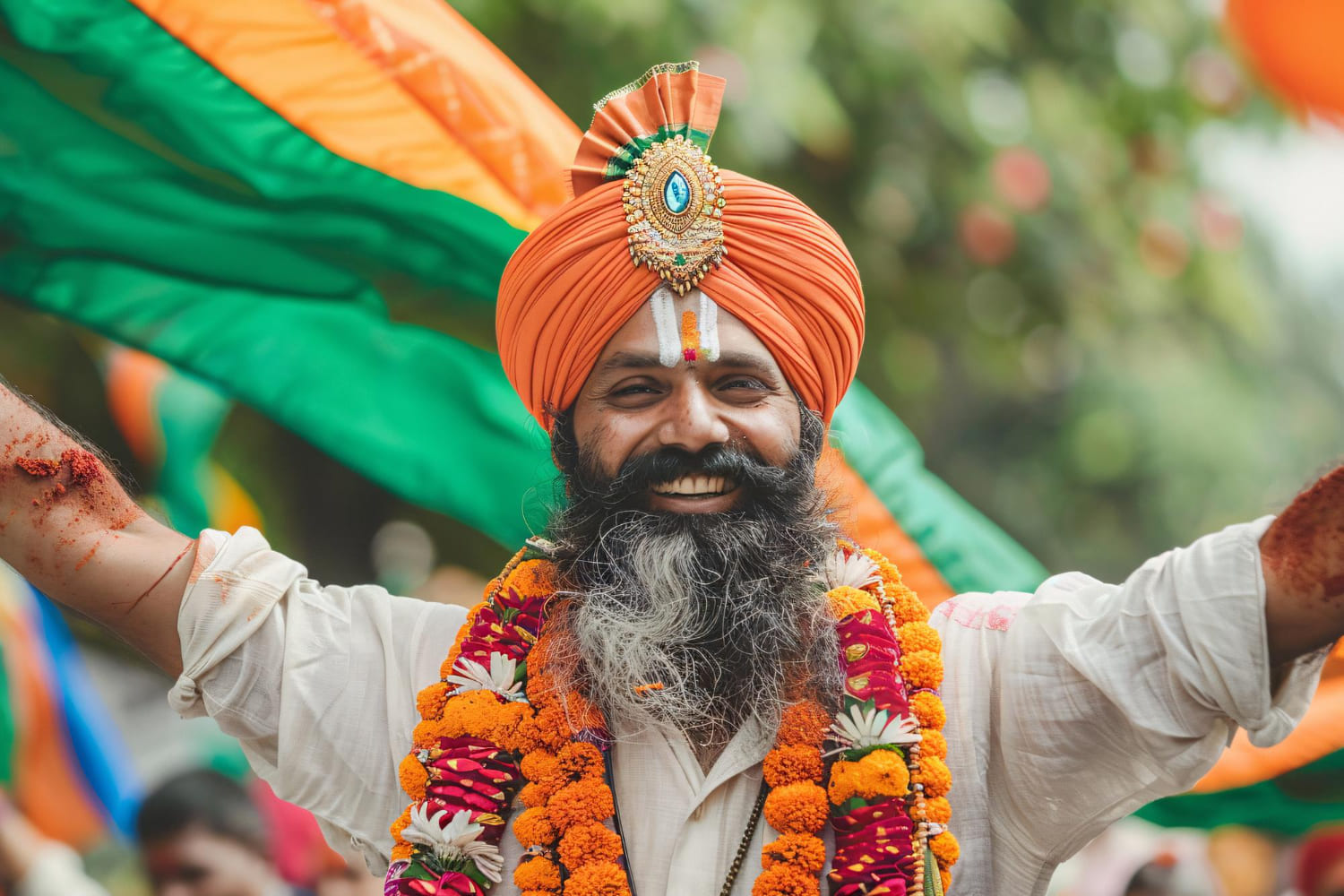Sikhism is a monotheistic religion founded in the 15th century in the Punjab region of India.
The religion is based on the teachings of ten Gurus, starting with Guru Nanak Dev Ji and ending with Guru Gobind Singh Ji. Sikhs believe in one God, who is formless, eternal, and all-powerful.
Sikhism has a rich history and culture, with a variety of traditions and customs that are observed by Sikhs all over the world.
These traditions and customs are an integral part of Sikhism, and are based on the teachings of the Gurus. They include religious festivals, daily prayers, and ethical practices.
Sikh festivals, such as Vaisakhi and Gurpurab, are celebrated with great enthusiasm and are an opportunity for Sikhs to come together and celebrate their faith.
Daily prayers, such as the morning prayer, are an important part of Sikhism and are a way for Sikhs to connect with God.
In this article, we will explore the various traditions and customs of Sikhism. We will provide a comprehensive guide to Sikh traditions, including a full list of festivals, prayers, and ethical practices.
Whether you are a Sikh looking to deepen your understanding of your faith, or someone interested in learning more about Sikhism, this guide will provide you with a wealth of information about Sikh traditions.
History of Sikhism
Sikhism is a monotheistic religion that originated in the Punjab region of India during the early Medieval period of the Bhakti movement. The religion was founded by Guru Nanak (1469-1539), who was the first of ten Gurus.
According to Sikh tradition, all ten human Gurus were inhabited by a single spirit, which is considered the eternal Guru.
During Mughal rule, which lasted between 1526-1857 A.D, the Hindu community in North India was repeatedly invaded by Muslim rulers.
This led to the emergence of Sikhism as a distinct religion, which was influenced by both Hinduism and Islam.
The Sikh community grew under the guidance of ten religious leaders, known as Gurus, who taught the principles of Sikhism.
During India’s struggle for independence, the Sikhs were on both sides of the conflict. Many continued to serve in the British military, while others opposed the colonial government.
The partition between India and Pakistan in 1947 produced deep dissatisfaction among the Sikhs, who saw the Punjab divided between the two new states.
Today, Sikhism is the world’s fifth-largest religion, with most of the world’s 25 million Sikhs living in India.
The religion is known for its emphasis on equality, service, and social justice, which are reflected in the Sikh practice of Langar, or communal kitchen, where everyone, regardless of caste, gender, or religion, is welcome to share a meal together.
Beliefs and Practices
Sikhism is a monotheistic religion that originated in the Punjab region of India during the 15th century. Sikhs believe in one God who is formless, eternal, and omnipresent.
They also believe in the concept of reincarnation, known as samsara, and karma, which is the law of cause and effect that governs each person’s destiny.
One of the most important beliefs in Sikhism is the idea of seva, which means selfless service. Sikhs believe that serving others is a way to serve God and to achieve spiritual growth. As a result, many Sikhs participate in charitable activities and volunteer work.
The Sikh code of conduct, known as the Sikh Rehat Maryada, outlines the practices and rituals that Sikhs should follow.
One of the most important practices is the recitation of the Guru Granth Sahib, which is the holy scripture of Sikhism.
Sikhs also participate in daily prayers and meditation, and many wear the five articles of faith, known as the Five Ks.
These include:
- Kesh: uncut hair
- Kanga: a wooden comb
- Kara: a steel bracelet
- Kaccha: cotton underwear
- Kirpan: a small sword
Another important practice in Sikhism is langar, which is a free community kitchen that provides meals to anyone who visits.
Langar is open to people of all faiths and backgrounds, and it is a way to promote equality and community service.
Overall, Sikhism emphasizes the importance of serving others, living a moral life, and connecting with God through prayer and meditation.
These beliefs and practices are central to the Sikh faith and are an important part of Sikh culture and tradition.
The Five Ks
The Five Ks or Panj Kakars are the five physical symbols that Sikhs wear as an outward sign of their faith. These symbols represent the Sikh’s commitment to a life of devotion and submission to the Guru.
The Five Ks are:
- Kesh: uncut hair, which is considered a gift from God and a symbol of Sikh identity and spirituality.
- Kanga: a wooden comb used to keep the hair clean and tidy.
- Kara: a steel bracelet worn on the wrist, symbolizing the Sikh’s commitment to the Guru and to the community.
- Kirpan: a ceremonial sword, representing the Sikh’s duty to defend the oppressed and uphold justice.
- Kachera: a specific style of undergarment, which is worn for comfort and modesty.
These Five Ks are an integral part of the Sikh faith and are worn by Amritdhari Sikhs, those who have undergone the Sikh baptism ceremony and have committed to following the Sikh code of conduct.
The Five Ks are also worn by many other Sikhs as a symbol of their faith and identity.
The wearing of the Five Ks is not just a physical act, but also a spiritual one. It is a way for Sikhs to constantly remind themselves of their commitment to the Guru and to the Sikh community.
The Five Ks also serve as a way for Sikhs to distinguish themselves from others and to show their pride in their faith.
Sikh Festivals and Celebrations
Sikhs celebrate a variety of festivals and celebrations throughout the year. These festivals are an important part of Sikh culture and are celebrated with great enthusiasm and devotion.
Here are some of the most important Sikh festivals and celebrations:
Vaisakhi
Vaisakhi is one of the most important festivals in the Sikh calendar. It is celebrated on April 13 or 14 every year and marks the birth of the Khalsa Panth. On this day, Sikhs gather at Gurdwaras to offer prayers and take part in processions.
Guru Nanak Jayanti
Guru Nanak Jayanti is celebrated to mark the birth anniversary of Guru Nanak Dev, the founder of the Sikh faith. It is celebrated in October or November every year and is one of the most important festivals in the Sikh calendar. On this day, Sikhs offer prayers and take part in processions.
Guru Gobind Singh Jayanti
Guru Gobind Singh Jayanti is celebrated to mark the birth anniversary of Guru Gobind Singh, the tenth Guru of the Sikhs. It is celebrated in December or January every year and is an important festival in the Sikh calendar. On this day, Sikhs offer prayers and take part in processions.
Holla Mohalla
Holla Mohalla is a festival that is celebrated by Sikhs a day after Holi. It is celebrated in March every year and is a time for Sikhs to come together and celebrate their faith. On this day, Sikhs take part in processions and perform Gatka, a form of martial arts.
Diwali
Diwali is a festival of lights that is celebrated by Sikhs and Hindus around the world. It is celebrated in October or November every year and is a time for families to come together and celebrate. On this day, Sikhs light candles and offer prayers.
These are just a few of the most important festivals and celebrations in the Sikh calendar. Sikhs also celebrate other festivals such as Bandi Chhor Divas, Maghi, and Shaheedi Jor Mela. Each festival has its own significance and is an important part of Sikh culture.
Sikh Wedding Traditions
The Sikh wedding ceremony, also known as Anand Karaj, is a beautiful and sacred event that involves several traditions and customs.
Here are some of the most important Sikh wedding traditions:
- Pre-Wedding Rituals: The pre-wedding rituals begin with the engagement ceremony, where the groom’s family visits the bride’s family to exchange gifts and sweets. This is followed by the chunni ceremony, where the groom’s family presents the bride with a red chunni (scarf) as a symbol of acceptance into their family. The next ceremony is the maiyan, where turmeric paste is applied to the bride and groom’s skin to purify them and bring good luck.
- The Wedding Ceremony: The Anand Karaj ceremony takes place in a Gurdwara (Sikh temple) and involves the recitation of hymns from the Sikh holy book, the Guru Granth Sahib. The bride and groom sit in front of the holy book while the priest recites the hymns. The couple then takes four rounds around the holy book, symbolizing their commitment to each other and to the Sikh faith. The ceremony ends with the ardaas, a prayer for the couple’s happiness and well-being.
- The Reception: The reception is a grand celebration that takes place after the wedding ceremony. It involves music, dancing, and feasting. The bride and groom usually make their grand entrance as a newly married couple, followed by speeches, toasts, and performances by family and friends.
Other important Sikh wedding traditions include the exchange of wedding rings, the giving of gifts to the bride and groom, and the tying of the wedding knot (known as the pheras).
Overall, Sikh weddings are a beautiful and joyous celebration of love and commitment, steeped in tradition and meaning.
Sikh Cuisine
Sikh cuisine is known for its rich and flavorful dishes that are deeply rooted in the culture and traditions of the Punjab region.
The cuisine is a blend of Indian, Persian, and Central Asian influences, and is characterized by the use of aromatic spices, herbs, and ghee (clarified butter).
One of the most famous dishes in Sikh cuisine is langar, a communal meal served in gurdwaras (Sikh temples) that is open to all regardless of caste, religion, or social status.
Langar typically consists of vegetarian dishes such as dal (lentil soup), chana masala (spiced chickpeas), and roti (flatbread).
Other popular dishes in Sikh cuisine include:
- Samosas: Small pockets of pastry filled with spiced potatoes, peas, and sometimes meat.
- Tandoori chicken: Chicken marinated in yogurt and spices, then cooked in a clay oven.
- Saag paneer: Spinach and cheese curry.
- Chole bhature: Spiced chickpeas served with deep-fried bread.
- Butter chicken: Chicken cooked in a creamy tomato sauce.
Sikh cuisine also includes a variety of sweets and desserts, such as gulab jamun (deep-fried milk balls soaked in syrup) and kheer (rice pudding).
It is important to note that Sikhism promotes vegetarianism and advocates for ethical treatment of animals. As such, many Sikh dishes are vegetarian, and meat dishes are typically prepared using halal methods.
Sikh Music and Arts
Sikh music and arts have played a significant role in the Sikh tradition since its inception. It exists in institutional, popular, and folk traditions, forms, and varieties.
Three types of Sikh musicians are rababis, ragis, and dhadhis. Rababis are descendants of Bhai Mardana, the Muslim minstrel who accompanied Guru Nanak, the founder of Sikhism. They play the rabab, a stringed instrument.
Ragis are trained in classical Indian music and specialize in singing hymns from the Guru Granth Sahib, the holy scripture of Sikhism. Dhadhis are ballad singers who sing stories of Sikh history and legends.
Sikh music is intended to lead the congregation in a process of contemplation. The elaborate rules and structures that govern how Sikh music is sung differentiate it from music as entertainment.
Kirtan is a tradition established by Guru Nanak and his minstrel companion Bhai Mardana. Traditional instruments used to perform Kirtan are an integral aspect of the Sikh worship service which is musical in nature.
Guru Granth Sahib, the holy scripture of Sikhism is a compilation of hymns composed in raag, India’s classical music system.
Sikh art and culture have merged with the different localities and ethnicities of different Sikhs into categories such as ‘Agrahari Sikhs’, ‘Dakhni Sikhs’, and ‘Assamese Sikhs’.
However, there has emerged a niche cultural phenomenon that can be described as ‘Political Sikh’. Sikh art and culture are expressed through various art forms such as paintings, calligraphy, sculptures, and textiles.
The art and architecture of gurdwaras, the place of worship for Sikhs, are also an important aspect of Sikh art.
Sikhism Today
Sikhism is a religion that is still practiced by millions of people around the world today. While the religion has gone through many changes over the centuries, its core beliefs and practices remain the same.
Here are some of the key aspects of Sikhism as it is practiced today:
- Basic Sikh Dharma Principles: The core principles of Sikhism include honesty, equality, and selflessness. Sikhs are encouraged to live their lives in accordance with these principles, and to treat all people with respect and compassion.
- Basic Tenets of the Sikh Religion: Sikhs believe in one God, who is the creator of all things. They also believe in the importance of meditation, and in the idea that all human beings are equal in the eyes of God.
- What is God to a Sikh? Sikhs believe that God is present in all things, and that it is possible to experience God through meditation and prayer.
- Creation and The World: Sikhs believe that the world was created by God, and that it is our duty to take care of it.
- Experiencing God in All: Sikhs believe that it is possible to experience God in all things, including nature and other people.
- Good and Evil: Sikhs believe that there is both good and evil in the world, and that it is our duty to fight against evil and promote goodness in all that we do.
- The Concept of Karma: Sikhs believe in the idea of karma, which suggests that our actions have consequences that will affect us in this life and in future lives.
- Reincarnation: Sikhs believe in the idea of reincarnation, and that our souls will continue to be reborn until we achieve spiritual liberation.
- The Afterlife: Sikhs believe that there is an afterlife, and that the quality of our actions in this life will determine our fate in the afterlife.
- Liberation: Sikhs believe that spiritual liberation is the ultimate goal of human existence.
- The Four Yugas: Sikhs believe in the cyclical nature of time, and that the world goes through four different yugas, or ages.
- The Aquarian Age: Sikhs believe that we are currently in the Aquarian Age, which is an age of spiritual awakening and enlightenment.
- Five Thieves and Eight Virtues: Sikhs believe in the importance of overcoming the five thieves of lust, anger, greed, attachment, and ego, and cultivating the eight virtues of truth, contentment, compassion, humility, love, patience, forgiveness, and faith.
- The Five Khands: Sikhs believe in the five khands, or realms of existence, which include the physical world, the astral world, the causal world, the spiritual world, and the realm of the absolute.
- Sikh Dharma and Vegetarianism: While Sikhs are not required to be vegetarians, many choose to abstain from eating meat as a way to show respect for all living beings.
Overall, Sikhism is a religion that emphasizes the importance of living a virtuous life, treating others with respect and compassion, and striving for spiritual enlightenment.
While the religion has evolved over the centuries, its core beliefs and practices remain the same, and continue to be embraced by millions of people around the world today.
Conclusion
Sikh traditions are rich and diverse, reflecting the faith’s long and complex history. From daily prayers and meditation to festivals and celebrations, Sikhism offers a wide range of practices and beliefs that are designed to help followers connect with the divine and lead a fulfilling life.
One of the key themes that runs throughout Sikhism is the importance of service and selflessness.
This is reflected in the many ways that Sikhs give back to their communities, from volunteering at local shelters and food banks to participating in large-scale humanitarian efforts around the world.
Another important aspect of Sikh traditions is the emphasis on equality and social justice. This is reflected in the faith’s rejection of caste and other forms of social hierarchy, as well as its commitment to promoting education, healthcare, and other basic human rights.
Overall, Sikh traditions are a testament to the enduring power of faith and community in shaping our lives and our world.
Whether you are a lifelong follower or simply curious about this fascinating faith, there is much to learn and appreciate in the rich tapestry of Sikh culture and tradition.







